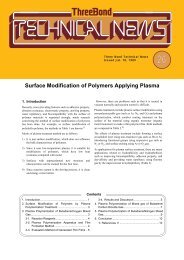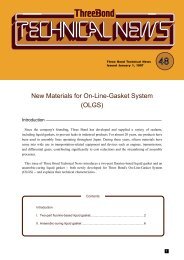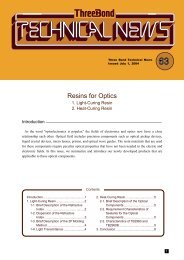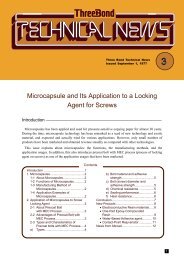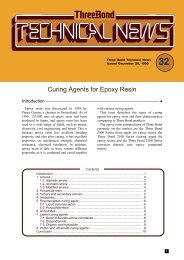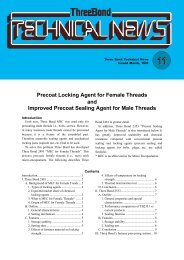Pressure resistance mechanism of reaction-type liquid gaskets (Part 2)
Pressure resistance mechanism of reaction-type liquid gaskets (Part 2)
Pressure resistance mechanism of reaction-type liquid gaskets (Part 2)
Create successful ePaper yourself
Turn your PDF publications into a flip-book with our unique Google optimized e-Paper software.
Conclusion<br />
With solid <strong>gaskets</strong>, the behavior <strong>of</strong> joint section is<br />
affected by vibration, loosening <strong>of</strong> bolts, and<br />
decrease in face pressure due to stress relaxation <strong>of</strong><br />
the gasket. The factors can cause leaks, since<br />
sealing performance depends on contact surface<br />
pressure at the joint section. In <strong>reaction</strong>-<strong>type</strong> <strong>liquid</strong><br />
<strong>gaskets</strong>, adhesion to the contact surface is<br />
maintained by the adhesive force <strong>of</strong> the gasket itself.<br />
Changes in inner boundary spaces or in clearances<br />
resulting from lower face pressure are <strong>of</strong>fset by<br />
elastic deformation <strong>of</strong> the gasket, maintaining<br />
sealing performance.<br />
The destruction <strong>of</strong> the gasket layer <strong>of</strong><br />
<strong>reaction</strong>-<strong>type</strong> <strong>liquid</strong> <strong>gaskets</strong> is caused by fluid<br />
pressure and flange opening. The <strong>mechanism</strong> <strong>of</strong><br />
destruction is elastic deformation. The internal<br />
stress upon a gasket layer is determined by the<br />
extent <strong>of</strong> deformation (strain), and the material<br />
failure equation is derived from the relationship<br />
between the adhesive force and cohesive force<br />
(including the elasticity term) <strong>of</strong> the material.<br />
As typical <strong>reaction</strong>-<strong>type</strong> <strong>gaskets</strong>, RTV silicone<br />
and anaerobic acryl represent suitable OLG (F.I.P.)<br />
materials. As this report indicates, a proper design<br />
<strong>of</strong> joint sections that takes full advantage <strong>of</strong> the<br />
properties <strong>of</strong> these materials (e.g., application to<br />
non-finished joint surface <strong>of</strong> castings) can result in<br />
significant cost savings for mechanical components.<br />
Very little real use research on <strong>reaction</strong>-<strong>type</strong><br />
<strong>gaskets</strong> has been performed. Progress will depend<br />
on the concerted study <strong>of</strong> flange systems design<br />
methods by manufacturers and end users. With<br />
candidate materials for <strong>reaction</strong>-<strong>type</strong> <strong>gaskets</strong><br />
extending beyond RTV silicone and anaerobic acryl,<br />
the development <strong>of</strong> alternate materials is another<br />
direction being pursued by <strong>liquid</strong> gasket<br />
manufacturers.<br />
Introduction <strong>of</strong> Group Company<br />
Three Bond Riken, Ltd.<br />
2-7-1 Nishishinjuku, Shinjuku-ku, Tokyo 160<br />
Tel: 03-342-3911<br />
Although the major products <strong>of</strong> the Three Bond<br />
Group are industrial materials, Three Bond Riken<br />
also develops and sells consumer goods for the<br />
general public.<br />
Three Bond Riken's "Care and Cleaning in Daily<br />
Life" series has been augmented by significant new<br />
product additions.<br />
Tatami Green, a newly-developed tatami mat<br />
cleaner that extends the life <strong>of</strong> tatami mats, has won<br />
great popularity. With a light surface coating,<br />
Tatami Green transforms a sun-stained or soiled<br />
tatami mat into a lush green.<br />
The coating can be performed with the tatami mat<br />
facing up, revitalizing old tatami mats and<br />
prolonging service life at a cost one-third <strong>of</strong> that<br />
required for re-covering or reversing. Preserves the<br />
original characteristics <strong>of</strong> new tatami mats,<br />
including air permeability.<br />
Three Bond Riken is devoted to the development<br />
<strong>of</strong> useful products based on careful observations <strong>of</strong><br />
daily life from varying perspectives. It is this<br />
approach that allows it to meet consumer demand.<br />
Contents <strong>of</strong> the next issue<br />
Micro-capsule and application to adhesive agents for<br />
screws<br />
1. Microcapsule<br />
1-1 What is a microcapsule?<br />
1-2 Microcapsule functions<br />
1-3 Microcapsule manufacturing process<br />
1-4 Examples <strong>of</strong> micro-capsule applications<br />
2. Application <strong>of</strong> microcapsule to adhesive agents for<br />
screws<br />
2-1 What is a Precoat Bolt with MEC Process?<br />
2-2 Characteristics <strong>of</strong> Precoat Bolt with MEC Process<br />
2-3 Types and characteristics <strong>of</strong> Precoat Bolt with<br />
MEC Process<br />
1456 Hazama-cho, Hachioji-shi, Tokyo 193-8533, Japan<br />
Tel: 81-426-61-1333<br />
6




